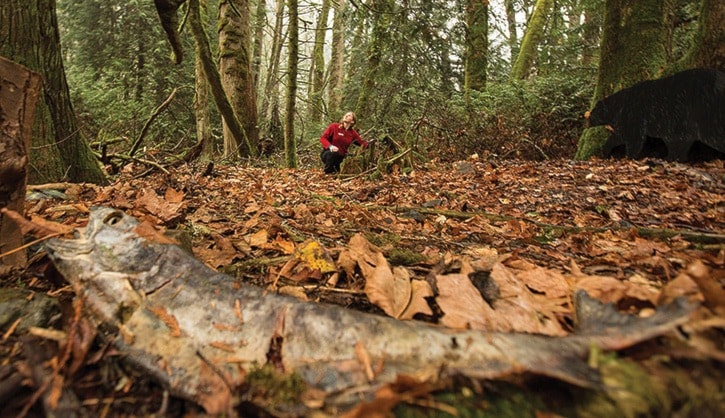Tracey Bleakley deftly evades decomposing salmon carcasses strewn about Goldstream Park.
Walking through the mossy forest bed, the long-time naturalist is part tour guide, carefully explaining the irreplaceable role salmon play in the delicately balanced eco-system of the park.
“This is one of nature’s phenomenons and has been happening for thousands of years,” she says.
The forest is thick with lush green, almost glowing moss alongside the Goldstream River which, halfway through spawning season, produces an unmistakable scent. From the ground to the tops of the trees, the ocean nutrients from the salmon have proven to be an invaluable asset to the eco system, Bleakley says – they’ve even been found in the tree tops of old-growth forest. She shares this fact with busloads of students every year at this time and hopes to do more as the season progresses.
“It’s a one of a kind experience being able to open their eyes and instil excitement,” she says. “It is really neat to have it concentrated on this six-to-eight week time period, because you have a chance to educate people on what is happening and how important the salmon are to the eco system.”
The salmon, dragged from the river beds by bears and other scavengers, end up several kilometres inland. Scientists have found the nutrients in local animals and neighbouring eco-systems. One day, Bleakley says, this information will fall into the care of the young students she sees from October to early December every year.
Bleakley sees varying generations of visitors come through the park and works with volunteers including Judith Parrish, a retired school teacher who brought her students to see the old-growth forest.
It’s important to get kids involved in nature,” Parrish says. “Unfortunately (some) environmentalists and naturalists talk about a nature deficit in children. I don’t know if that has come about because of the increase in television and video, or because of the business of parents, but there isn’t enough time to enjoy what nature has to offer.”
School programs are a real eye opener for parents and children alike, she says. They inform not just about salmon spawning, but about the multi-dimensional ecological system. “The experiential approach to learning is the best way and that’s what they do here … there is a lot going on. (Most) have never seen anything like it before. We don’t ever see kids who are bored, we see kids that are excited.”
Salmon spawning tours and programming run until early December. For details, visit naturehouse.ca.
alim@goldstreamgazette.com
